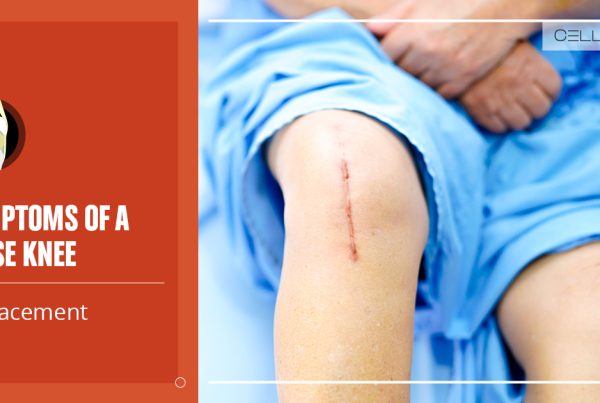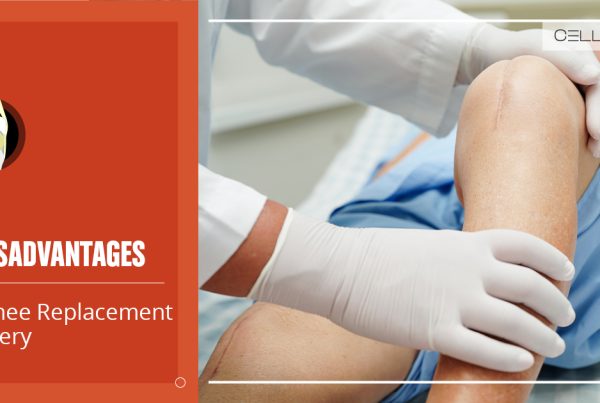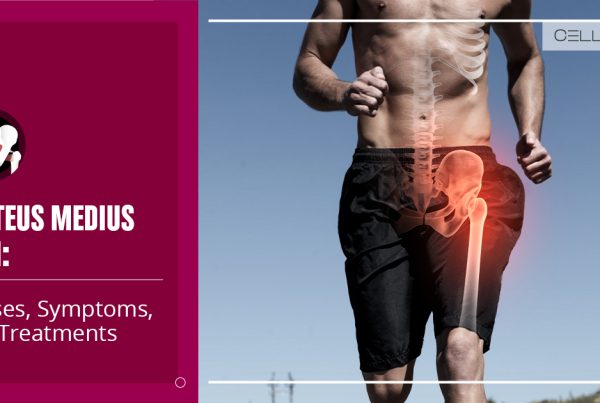Published on: October 10, 2019 | Updated on: November 3, 2024
Our knees are used in almost all daily activities, from standing to sitting, walking to sleeping. Knee pain can be particularly devastating, as it can quickly alter the quality of life and enjoyment of daily activities.
The causes of knee pain vary from person to person. If movement and pain levels become too high, knee replacement surgery may be a possibility. In fact, over 90% of patients who have undergone the surgery state it helped them feel better.
While the operation’s benefits may exceed the short-term discomfort, it is crucial to have realistic expectations about the recovery time and post-surgery knee pain.
How long does pain last after knee replacement surgery? Let’s find out.
Do you have Knee Pain?
Fill out the form below to schedule your FREE virtual consultation
Anatomy of the Knee
The knee consists of three bones: the tibia (shin bone), the femur (thigh bone), and the patella (kneecap). These bones align for the necessary movements and daily functions humans rely on. The muscles, tendons, and ligaments surrounding the knee serve as stabilizing agents.
There is fleshy cartilage between the bones called bursa, which acts as a cushion and prevents the bones from rubbing against one another.
When someone experiences pain in the knee, there are several potential causes. The three most common are:
- Osteoarthritis: Soft tissues in the body degrade naturally over time. When the cushions between bones begin to deteriorate, and the bones begin to rub against each other, this is called arthritis. This condition can cause a great deal of pain and occurs predominantly in people over the age of 50, but it can happen to anyone at any time.
- Injury: An injury can occur for many reasons, including a sports injury, falling, or a traumatic injury such as a car accident. When these occur, the bones not only experience trauma but may realign in such a way that causes pain. These can include torn cartilage, a torn ACL, or broken bones.
Overuse: Repetitive motion in the knee can lead to more rapid degeneration of the soft tissue.
Specific individuals may be more prone to knee pain than others due to their lifestyle. These people include:
- Athletes: The overuse of a joint can contribute to pain over time, as well as make someone more prone to injury.
- Overweight Individuals: The more weight the knee joint bears, the more stress it will be under. Over time, this added stress can lead to more rapid degeneration.
- Seniors: As soft tissue degrades over time, arthritis sets in, leading to joint pain and discomfort.
There are many more potential causes of knee pain, as the network surrounding the knee is intricately composed and there are many different things that can go wrong. Having an open discussion with a doctor about it is the first step to proper diagnosis and treatment.
Conventional Treatment Methods for Knee Pain
Knee pain is treated in various ways. Once the cause is diagnosed, a treatment plan is set in motion using proper techniques. Doctors use information such as a patient’s medical history, overall health, activity level, and comfort level to create a unique treatment plan for each patient.
These plans typically enact the RICE method, which stands for Rest, Ice, Compression, and Elevation. Sometimes, patients also take over-the-counter NSAIDs (Non-Steroidal Anti-Inflammatory Drugs) such as ibuprofen. Inflammation often causes pain, so these methods can help subside the pain.
If these less invasive methods fail to relieve pain, doctors will turn to slightly more intense treatment methods such as physical therapy or corticosteroid injections. Physical therapy seeks to strengthen muscles surrounding an injury and increase a patient’s range of motion.
Corticosteroid injections involve injecting a potent anti-inflammatory agent directly into the pain area. While this is most often successful at relieving pain in the short term, it has been proven to damage tissue over time. Therefore, corticosteroid injections are not considered a long-term solution to knee pain.
After undergoing slightly more invasive treatments and still failing to see results, doctors may discuss surgery as an option. Initial surgeries for knee pain are less invasive than a total knee replacement. These surgeries may include:
- Arthroscopy: Using tiny surgical tools, doctors can repair some damage, realign muscles or tendons, and remove problematic tissues. This type of surgery is minimally invasive but is not always capable of correcting all of the damage that has occurred.
- Partial Knee Replacement: Depending on the nature of the injury or damage, doctors may elect to replace certain aspects of the knee that are causing pain. Whereas arthroscopy mostly rearranges existing structures, partial knee replacement uses foreign objects made of metal or plastic to replace parts of bone or muscle with a more functional piece.
The recovery time for these procedures varies from patient to patient but usually takes anywhere from a couple of months to over a year. An individual’s commitment to the healing process, dedication to physical therapy, body’s healing properties, and many other factors play roles in the recovery process.
In some cases, knee pain will persist even after the initial surgery. When this is the case, the option of total knee replacement is discussed.
Total Knee Replacement Surgery
Total knee replacement begins with removing the damaged parts of the femur and tibia. They are then shaped to accommodate best the foreign objects used as replacements. The ends of the tibia and femur are fitted with a piece of metal. The piece of metal on the tibia is attached to a piece of plastic. The patella is also sometimes equipped with a piece of plastic.
These foreign objects allow for smooth motion in the knee, and removing the damaged parts can prevent further degeneration or injury.
Life After Total Knee Replacement Surgery
Patients undergoing total knee replacement surgery will each have a different recovery process. Typically, being able to stand up and even walk to the bathroom can occur hours after surgery. Patients are often discharged from the hospital after a matter of days but are encouraged to continue specific exercises.
Many of the initial exercises can be done from bed. The recommended exercises will change as the patient becomes more able to move around. The goals of these exercises are:
- Strengthening Muscle: The muscles surrounding the knee provide support, and if they lay idle after surgery, they can become weak and no longer provide support. Exercising them as recommended will make the healing process more efficient.
- Prevent Blood Clots: Immediately after surgery, patients become more prone to clotting as the body attempts to heal. Sometimes, an anticoagulant medication is prescribed briefly to prevent this.
- Improve Range of Motion: If knee muscles are not used, they will stiffen. This interferes with the recovery process and makes it more difficult for patients to undergo physical therapy.
Physical therapy is recommended for several months following surgery. Pain management is key to successful recovery, as managing pain leads to more fruitful physical therapy. Pain management post-operation typically begins with the prescription of pain medication.
Then, as time goes on and the body heals, patients are recommended to wean off prescribed medication and begin the use of over-the-counter drugs.
Many patients will employ an ambulatory aid such as a cane or walker at the beginning of their recovery. These tools allow patients to relieve some of the pressure that would otherwise be placed on the knee. Many patients begin with a walker and switch to a cane later in recovery once the knee can withstand more pressure.
Factors That Affect the Duration of Pain
How long does pain last after knee replacement surgery? Several factors may affect the degree and longevity of pain post-surgery.
- Older people with greater body mass and weight will take longer to recover.
- Those suffering from arthritis and diabetes or other conditions like a history of knee injuries too will take longer to heal.
- Partial knee replacement surgery has less tissue damage, whereas total knee replacement has higher tissue damage, causing lasting pain and different timelines.
- Patients who complete physical therapy recover faster and have better-managed pain.
Recovery Timeline
The amount of time it will take to feel no pain differs for everyone. This is generally referred to as a “recovery timeline”. Patients usually report reduced pain within 3-5 weeks. After six weeks, patients enjoy increased mobility, and some can return to driving.
Pain has become less of an issue, but stiffness and soreness, which can cause discomfort, have replaced it. By the 11th week, patients should almost be able to return to their lives before surgery.
The timeline above for recovery depends entirely on a patient’s commitment to physical therapy and dedication to following their doctor’s recommendations. Using medication will make this process more comfortable for patients. Alternative treatments may help with pain and speed up recovery time.
Immediately Post Surgery
Within the first three days after surgery, you will be in high to moderate pain; there’s no hiding the fact. Since there will be surgical trauma on the knee joint, the place of the incision and the surrounding tissue will hurt.
You will be given strong pain relievers like opioids and local anesthesia to manage the pain in the hospital at this time.
Early Recovery Phase
In the first four weeks, you will feel moderate to mild pain. Healing will begin, and there will be physical movement, but inflammation and swelling will be present, so keep things light.
The pain will now be managed with medications and physical and ice therapy. If you feel discomfort while walking, so crutches and walkers are recommended.
Mid-Recovery Phase
Thereon, the pain becomes mild to occasionally moderate and lasts up to three months after strenuous activity.
Things are still healing, and any discomfort or stress can cause pain. Continue physical therapy and pain-relieving oral medication as prescribed to manage pain.
Late Recovery Phase
The pain will further mellow down with less frequent episodes of intensity. The scar tissue may not have healed by now, but the joint inside should have completely healed. Any pain patients feel at this point is usually due to increased activity or scar tissue buildup.
To manage the pain at this stage, engage in active walks and mild physical activities.
Long-Term Pain
Pain beyond six months lasting up to a year is mild and minimal, if any. This is enough time for the joint to have completely healed up. However, there may be complications like nerve damage, osteoarthritis, and improper implant placement.
If the pain persists, you may need medical evaluation or revision surgery.
Benefits of Regenerative Medicine After Total Knee Replacement Surgery
The relatively new field of regenerative therapies offers patients with many ailments new hope. The two forms of therapies offered at CELLAXYS are:
- Autologous Stem Cell Therapy: This therapy involves harvesting stem cells already in the body. They are typically taken from adipose tissue or fat cells but can also be taken from bone marrow. The stem cells are processed to become more concentrated and reinjected into the area where an injury or degeneration has occurred.
- Platelet-Rich Plasma Therapy: This therapy begins with a blood draw. The blood is then placed into a centrifuge, which separates platelets from other components in the blood. Platelets are an aspect of blood that contains proteins, growth factors, and anti-inflammatory proteins (cytokines). They are crucial to healing, from paper cuts to knee surgery. The concentrated platelets are then injected into the area where the pain occurs.
Both of these forms of therapy use the body’s healing processes, amplifying them to heal more intensely.
Both procedures use an imaging technique, such as ultrasound or live X-ray, to pinpoint the exact location where the drugs should be injected to provide the greatest benefit.
These outpatient procedures typically take less than two hours to complete. Most are performed under light or moderate anesthesia, known as “conscious sedation,” similar to colonoscopies.
The goal of regenerative therapy is twofold: it seeks to reduce pain and aid the healing process, which in turn can prevent further damage in the long term. Patients have reported feeling reduced pain in as little as a couple of days, but most patients see results within weeks.
After a total knee replacement surgery, a patient may consider regenerative therapy for its healing properties. The replacement surgery is a drastic measure, and on its own, it can take a long time to recover fully. Regenerative therapies offer a sort of “boost” in the recovery process. These types of injections allow the muscles surrounding the surgery to repair faster, providing more stability to the joint. They also offer healing properties to the bones placed under immense stress from the surgery.
These therapies could reduce pain felt after a knee replacement surgery. The recovery above the timeline may also be altered for the better. Recovering more quickly means patients can return to their normal lives more quickly.
Sources
Footnotes
- Grosu I, Lavand’homme P, Thienpont E. Pain after knee arthroplasty: an unresolved issue. Knee Surgery, Sports Traumatology, Arthroscopy. 2014;22:1744-58.
- Moore AJ, Gooberman‐Hill R. Why don’t patients seek help for chronic post‐surgical pain after knee replacement? A qualitative investigation. Health Expectations. 2020;23(5):1202-12.
- MacKichan F, Wylde V, Gooberman‐Hill R. Pathways through care for long‐term pain after knee replacement: a qualitative study with healthcare professionals. Musculoskeletal Care. 2015;13(3):127-38.
- Phillips JR, Hopwood B, Stroud R, Dieppe PA, Toms AD. The characterisation of unexplained pain after knee replacement. British journal of pain. 2017;11(4):203-9.
- Jeffery AE, Wylde V, Blom AW, Horwood JP. “It’s there and I’m stuck with it”: patients’ experiences of chronic pain following total knee replacement surgery. Arthritis care & research. 2011;63(2):286-92.
References
- Recovering from a knee replacement. NHS. Accessed 2/22/2024.
- What to Expect After Knee Replacement. ARTHRITIS-Health. Accessed 2/22/2024.
- Total Knee Replacement. OrthoInfo. Accessed 2/22/2024.
- Arthritis of the Knee. OrthoInfo. Accessed 2/22/2024.
- Bursitis. The Johns Hopkins Hospital. Accessed 2/22/2024.
CELLAXYS does not offer Stem Cell Therapy as a cure for any medical condition. No statements or treatments presented by Cellaxys have been evaluated or approved by the Food and Drug Administration (FDA). This site contains no medical advice. All statements and opinions are provided for educational and informational purposes only.
Dr Pejman Bady
Author
Dr. Pejman Bady began his career over 20 years ago in Family/Emergency Medicine, working in fast-paced emergency departments in Nevada and Kansas. He has served the people of Las Vegas as a physician for over two decades. Throughout this time, he has been met with much acclaim and is now the head of Emergency Medical Services in Nye County, Nevada. More about the doctor on this page.
Dr Pouya Mohajer
Contributor
Pouya Mohajer, M.D. is the Director of Spine and Interventional Medicine for CELLAXYS: Age, Regenerative, and Interventional Medicine Centers. He has over 20 years of experience in pain management, perioperative medicine, and anesthesiology. Dr. Mohajer founded and is the Medical Director of Southern Nevada Pain Specialists and PRIMMED Clinics. He has dedicated his career to surgical innovation and scientific advancement. More about the doctor on this page.










